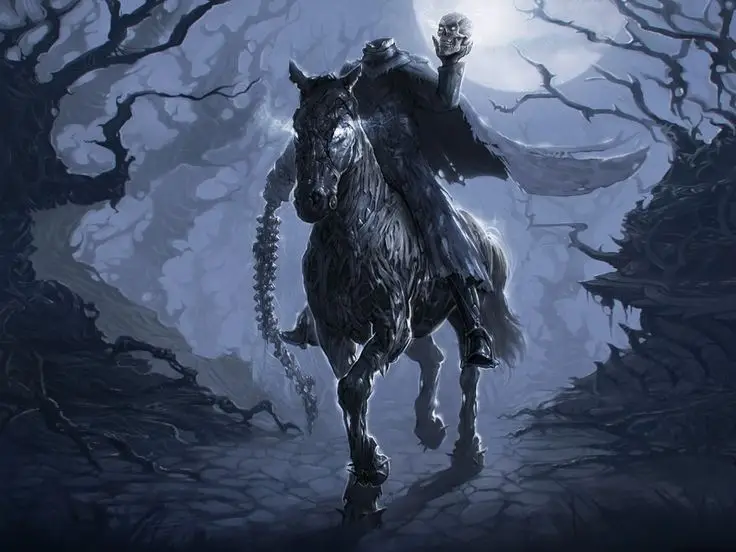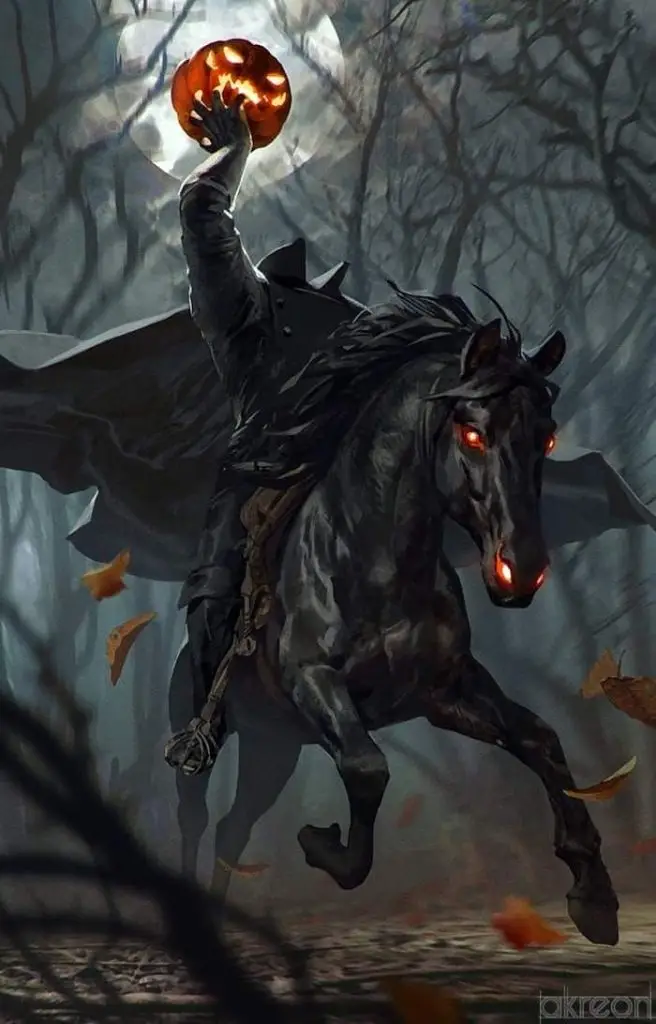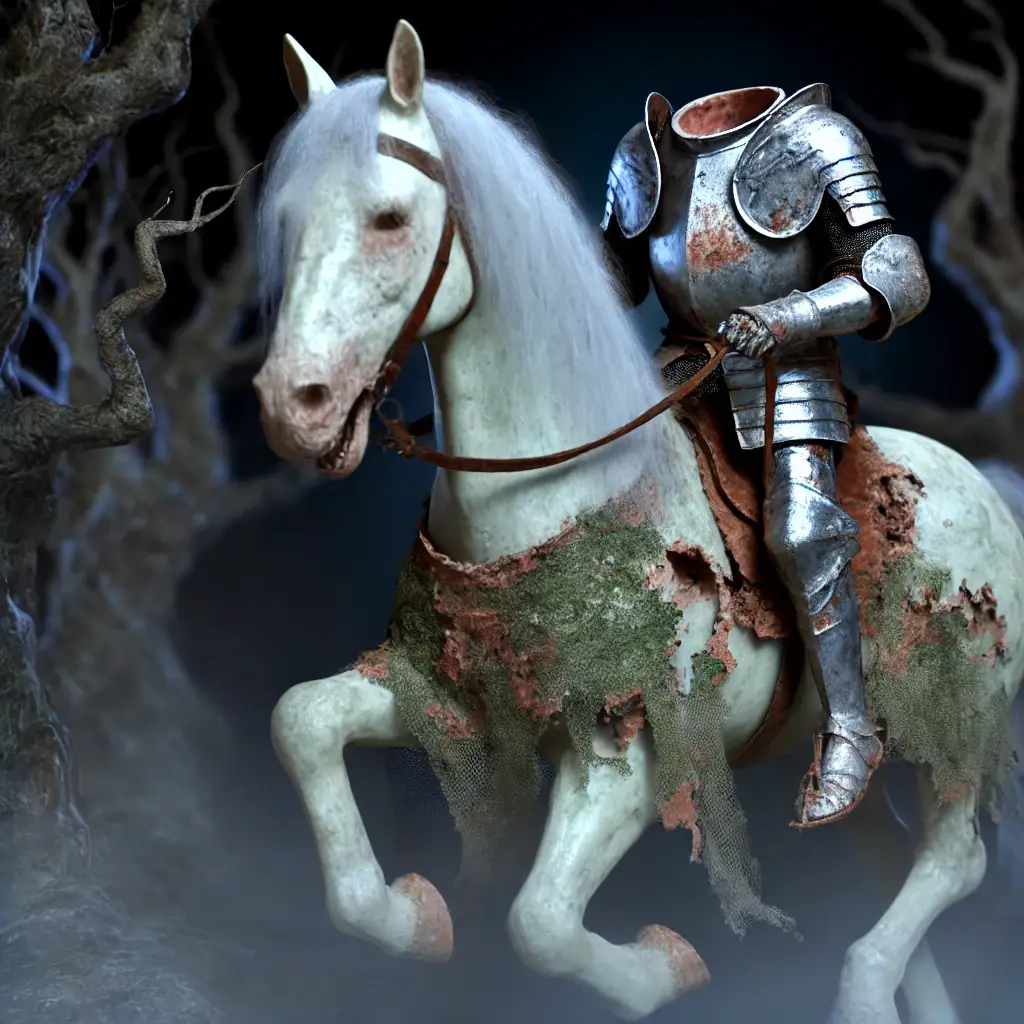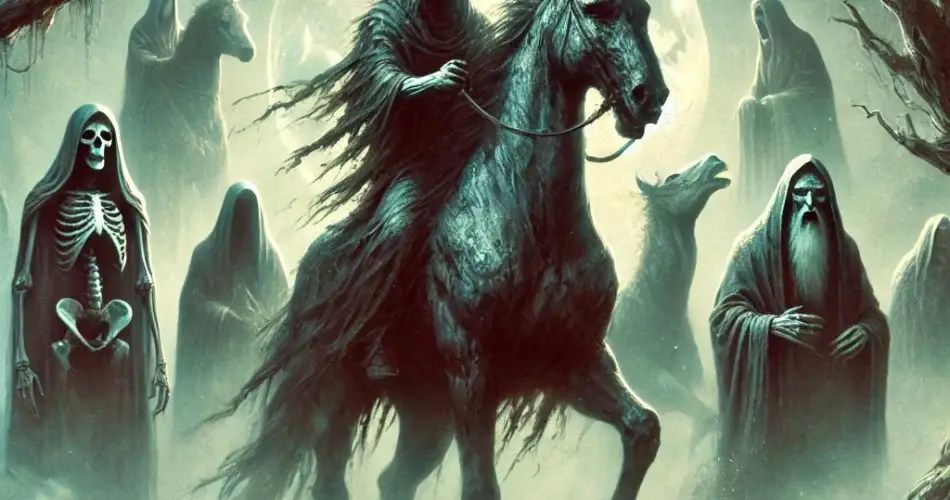The headless horseman is a central theme that appears in various myths and legends all around the world. In these ancient stories, the headless horseman is usually a harbinger of death, a vengeful spirit, or a cursed soul doomed to wander the earth. This article explores some of the headless horse riders from ancient mythology.
1. The Dullahan (Irish Mythology)

The Dullahan is one of the most well-known headless horsemen in mythology, originating from Irish Folklore. This mythical creature is depicted as a dark, ominous figure riding a black horse across the Irish countryside.
He is a harbinger of death, and his appearance signals that someone nearby is about to die. This mythical creature carries his head under one arm, and the eyes on this head are said to have the ability to see great distances, even in total darkness. The head is grotesque, with a mouth that grins from ear to ear and skin that resembles mouldy cheese.
He rides during the night, stopping only at the home of someone about to die. He calls out the person’s name to collect the soul. Anyone unfortunate to see the Dullahan is struck blind or marked by the creature as the next target.
2. The Headless Horseman of Sleepy Hollow (American Folklore)

The Headless Horseman from Washington Irving’s “The Legend of Sleepy Hollow” has become an iconic figure in American Folklore. The story is set during the American Revolutionary War and features the ghost of a Hessian soldier who lost his head to a cannonball during battle.
This fallen soldier rides through the town of Sleepy Hollow in search of his missing head, terrifying the local inhabitants.
He is typically described as wearing a long, dark cloak and riding a black horse. The horseman emerges at night, particularly near the Old Dutch Church, where he is said to be buried. He relentlessly pursues anyone who dares to cross his path, especially Ichabod Crane, the protagonist of the story.
3. The Wild Hunt (Germanic Mythology)
In Germanic mythology, the Wild Hunt is a spectral procession of ghostly riders, often led by a headless horseman. This headless rider is a foreboding figure, signalling disaster or death to those who witness the hunt. The leader of the Wild Hunt varies in different myths. It is sometimes depicted as the god Odin or a legendary king.
The headless horseman in these tales is often portrayed as a shadowy, armoured figure riding a mighty steed that moves with supernatural speed. The Wild Hunt sweeps through the sky or across the land, often during stormy weather, and those who see it are cursed with bad luck.
4. El Muerto (Mexican Folklore)
El Muerto is a Spanish term that translates to “The Dead One”. It is a figure from Mexican Folklore, particularly in the border regions of Texas and Mexico.
The legend tells of a notorious bandit who was captured by Texas Rangers and beheaded as punishment for his crimes. His headless body was then tied to his horse, which was set free to roam the plains.
El Muerto is often depicted as a ghostly figure, still wearing his tattered clothing and riding a horse that moves silently through the night. He is said to be seeking revenge on those who wronged him when he was alive, and it is said that encountering El Muerto can lead to a curse or misfortune.
5. The Nukekubi (Japanese Mythology)
In Japanese mythology, the Nukekubi are supernatural beings whose heads detach from their bodies to hunt for human prey at night. Although not traditionally a horseman, the Nukekubi are sometimes depicted as ghostly riders in certain regional tales.
They appear as ordinary humans during the day, but their heads fly off at night, leaving their bodies behind to roam the land. The detached heads have sharp fangs and glowing eyes, and they attack unsuspecting victims, draining their life force. The Nukekubi target the living at night, returning to their bodies before dawn to avoid detection.
6. Sir Gawain and the Green Knight (Arthurian Legend)
The tale of Sir Gawain and the Green Knight from Arthurian legend presents another instance of a headless horseman. The Green Knight is a mysterious figure who challenges Sir Gawain to a beheading game. After Gawain decapitates him, the Green Knight miraculously picks up his head and rides away, only to return a year later to fulfil the agreement.
The Green Knight is often depicted as a towering figure clad in green armour, riding a large green horse. His head, once severed, continues to speak, issuing a challenge to Gawain. The Green Knight operates by testing the honour and bravery of knights, using his supernatural abilities to push them to their limits.
7. The Erynnies (Greek Mythology)
In Greek mythology, the Erynnies, or Furies, are goddesses of vengeance who are sometimes depicted as headless horse riders. These terrifying deities pursue those who have committed grave sins, particularly murder, driving them to madness.
The Erynnies are usually depicted as winged women with serpentine hair, and when shown as headless horse riders, they are even more terrifying. They operate by relentlessly hunting down their victims, often appearing suddenly and without warning, bringing about swift and brutal justice.
8. The Headless Templar (Spanish Folklore)

In Spanish Folklore, particularly in regions influenced by the Knights Templar, there are tales of a headless Templar knight who rides his horse in search of revenge. This ghostly figure is often depicted as a spectral knight clad in armour, riding a pale horse.
The Headless Templar operates by guarding hidden treasures or seeking vengeance against those who betrayed him. He is said to be cursed, unable to find peace until he achieves his goal.
9. The Death Coach (Scottish Folklore)
Like the Irish Dullahan, Scottish Folklore features a spectral coach known as the “Death Coach,” often driven by a headless horseman. The Death Coach is a harbinger of death, collecting the souls of the dead.
The headless horseman in these tales is a grim figure clad in dark, tattered robes and riding a ghostly horse that pulls the coach. The Death Coach operates by appearing at the homes of those about to die, and the coach’s appearance is a sure sign that death is near.
Conclusion
Headless horsemen are powerful symbols in mythology, representing death, vengeance, and the supernatural in various cultures.
These eerie figures captivate the imagination and remind us of the mysterious and often terrifying aspects of the afterlife.
